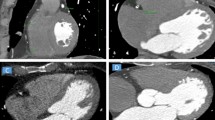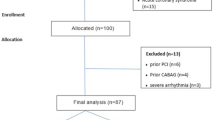Abstract
Human epicardial adipose tissue (EAT) is a type of visceral adipose tissue functioning as an endocrine organ by secreting hormones and adipocytokines which have an important role in the atherosclerotic process. In this study, we aimed to assess the relationship between EAT measured by dual source multidetector computed tomography (MDCT) and descending thoracic aorta (DTA) atherosclerosis. A total of 148 patients who underwent MDCT for the evaluation of coronary artery disease were enrolled in this study. Thickness of the EAT was measured on contrast enhanced multiplanar reformat images with parasternal short axis view at basal, mid-ventricular and apical levels and horizontal long axis view. The atherosclerotic plaque was scored from 0 to 4 points by the percentage of the luminal surface at the cross sectional area of proximal, mid and distal segments of descending aorta. Among the study population, 84 (56.8%) were male and age was (mean ± standart deviation) 56.9 ± 11.7 years. In patients with critical coronary atherosclerosis, DTA atherosclerosis had a significant relationship with EAT (P = 0.012). Multivariate linear regression analysis revealed that in addition to critical coronary stenosis, age and total epicardial fat thickness were associated with aortic atherosclerosis (β value, 0.058 and 0.035; t value, 4.74 and 2.28, respectively; P < 0.05) after adjustment for traditional cardiovascular risk factors. In this study we demonstrated that atherosclerotic plaque burden of DTA was associated with the amount of EAT thickness among patients with suspected CAD shown by MDCT. Further large scale prospective studies are needed to address the interaction of EAT as well as the mediators of inflammation and adipocytokines with the development of atherosclerotic plaques in aorta and effects on cardiovascular outcomes.



Similar content being viewed by others
References
Rosamond W, Flegal K, Furie K, Go A, Greenlund K, Haase N, Hailpern SM, Ho M, Howard V, Kissela B, Kittner S, Lloyd-Jones D, McDermott M, Meigs J, Moy C, Nichol G, O’Donnell C, Roger V, Sorlie P, Steinberger J, Thom T, Wilson M, Hong Y (2008) Heart disease and stroke statistics–2008 update: a report from the American Heart Association Statistics Committee and Stroke Statistics Subcommittee. Circulation 117(4):e25–146. doi:10.1161/CIRCULATIONAHA.107.187998
Yorgun H, Hazirolan T, Kaya EB, Canpolat U, Sunman H, Ertugrul O, Ates AH, Aksoy H, Aytemir K, Tokgozoglu L, Kabakci G, Oto A (2010) Aortic atherosclerosis predicts the extent and severity of coronary atherosclerosis detected by multidetector computed tomography coronary angiography. Angiology 61(7):627–632. doi:10.1177/0003319710362976
Nishino M, Masugata H, Yamada Y, Abe H, Hori M, Kamada T (1994) Evaluation of thoracic aortic atherosclerosis by transesophageal echocardiography. Am Heart J 127(2):336–344
Taniguchi H, Momiyama Y, Fayad ZA, Ohmori R, Ashida K, Kihara T, Hara A, Arakawa K, Kameyama A, Noya K, Nagata M, Nakamura H, Ohsuzu F (2004) In vivo magnetic resonance evaluation of associations between aortic atherosclerosis and both risk factors and coronary artery disease in patients referred for coronary angiography. Am Heart J 148(1):137–143. doi:10.1016/j.ahj.2004.03.008
Sarin S, Wenger C, Marwaha A, Qureshi A, Go BD, Woomert CA, Clark K, Nassef LA, Shirani J (2008) Clinical significance of epicardial fat measured using cardiac multislice computed tomography. Am J Cardiol 102(6):767–771. doi:10.1016/j.amjcard.2008.04.058
Silaghi A, Achard V, Paulmyer-Lacroix O, Scridon T, Tassistro V, Duncea I, Clement K, Dutour A, Grino M (2007) Expression of adrenomedullin in human epicardial adipose tissue: role of coronary status. Am J Physiol Endocrinol Metab 293(5):E1443–E1450. doi:10.1152/ajpendo.00273.2007
Poirier P, Despres JP (2003) Waist circumference, visceral obesity, and cardiovascular risk. J Cardiopulm Rehabil 23(3):161–169
Despres JP, Lemieux I (2006) Abdominal obesity and metabolic syndrome. Nature 444(7121):881–887. doi:10.1038/nature05488
Fain JN, Madan AK, Hiler ML, Cheema P, Bahouth SW (2004) Comparison of the release of adipokines by adipose tissue, adipose tissue matrix, and adipocytes from visceral and subcutaneous abdominal adipose tissues of obese humans. Endocrinology 145(5):2273–2282. doi:10.1210/en.2003-1336
Scherer PE (2006) Adipose tissue: from lipid storage compartment to endocrine organ. Diabetes 55(6):1537–1545. doi:10.2337/db06-0263
Sacks HS, Fain JN (2007) Human epicardial adipose tissue: a review. Am Heart J 153(6):907–917. doi:10.1016/j.ahj.2007.03.019
Wang TD, Lee WJ, Shih FY, Huang CH, Chang YC, Chen WJ, Lee YT, Chen MF (2009) Relations of epicardial adipose tissue measured by multidetector computed tomography to components of the metabolic syndrome are region-specific and independent of anthropometric indexes and intraabdominal visceral fat. J Clin Endocrinol Metab 94(2):662–669. doi:10.1210/jc.2008-0834
Ouwens DM, Sell H, Greulich S, Eckel J (2010) The role of epicardial and perivascular adipose tissue in the pathophysiology of cardiovascular disease. J Cell Mol Med 14(9):2223–2234. doi:10.1111/j.1582-4934.2010.01141.x
Report of the Expert Committee on the Diagnosis and Classification of Diabetes Mellitus (1997). Diabetes Care 20(7):1183–1197
Chobanian AV, Bakris GL, Black HR, Cushman WC, Green LA, Izzo JL Jr, Jones DW, Materson BJ, Oparil S, Wright JT Jr, Roccella EJ (2003) Seventh report of the Joint National Committee on Prevention, Detection, Evaluation, and Treatment of High Blood Pressure. Hypertension 42(6):1206–1252. doi:10.1161/01.HYP.0000107251.49515.c2
Agmon Y, Khandheria BK, Meissner I, Schwartz GL, Petterson TM, O’Fallon WM, Gentile F, Whisnant JP, Wiebers DO, Seward JB (2000) Independent association of high blood pressure and aortic atherosclerosis: A population-based study. Circulation 102(17):2087–2093
Khoury Z, Gottlieb S, Stern S, Keren A (1997) Frequency and distribution of atherosclerotic plaques in the thoracic aorta as determined by transesophageal echocardiography in patients with coronary artery disease. Am J Cardiol 79(1):23–27. doi:S0002914996006704[pii]
Verhagen SN, Visseren FL (2010) Perivascular adipose tissue as a cause of atherosclerosis. Atherosclerosis. doi:10.1016/j.atherosclerosis.2010.05.034
Ahn SG, Lim HS, Joe DY, Kang SJ, Choi BJ, Choi SY, Yoon MH, Hwang GS, Tahk SJ, Shin JH (2008) Relationship of epicardial adipose tissue by echocardiography to coronary artery disease. Heart 94(3):e7. doi:10.1136/hrt.2007.118471
Mazurek T, Zhang L, Zalewski A, Mannion JD, Diehl JT, Arafat H, Sarov-Blat L, O’Brien S, Keiper EA, Johnson AG, Martin J, Goldstein BJ, Shi Y (2003) Human epicardial adipose tissue is a source of inflammatory mediators. Circulation 108(20):2460–2466. doi:10.1161/01.CIR.0000099542.57313.C5
Spiroglou SG, Kostopoulos CG, Varakis JN, Papadaki HH (2010) Adipokines in periaortic and epicardial adipose tissue: differential expression and relation to atherosclerosis. J Atheroscler Thromb 17(2):115–130. doi:JST.JSTAGE/jat/1735[pii]
Di Tullio MR, Sacco RL, Homma S (1996) Atherosclerotic disease of the aortic arch as a risk factor for recurrent ischemic stroke. N Engl J Med 335(19):1464. doi:10.1056/NEJM199611073351913 (author reply 1464-1465)
Montgomery DH, Ververis JJ, McGorisk G, Frohwein S, Martin RP, Taylor WR (1996) Natural history of severe atheromatous disease of the thoracic aorta: a transesophageal echocardiographic study. J Am Coll Cardiol 27(1):95–101. doi:10.1016/0735-1097(95)00431-9
Okuyama T, Ehara S, Shirai N, Sugioka K, Yamashita H, Kataoka T, Naruko T, Itoh T, Otani K, Matsuoka T, Inoue Y, Ueda M, Yoshikawa J, Hozumi T, Yoshiyama M (2008) Assessment of aortic atheromatous plaque and stiffness by 64-slice computed tomography is useful for identifying patients with coronary artery disease. Circ J 72(12):2021–2027. doi:JST.JSTAGE/circj/CJ-08-0396[pii]
Gorter PM, van Lindert AS, de Vos AM, Meijs MF, van der Graaf Y, Doevendans PA, Prokop M, Visseren FL (2008) Quantification of epicardial and peri-coronary fat using cardiac computed tomography; reproducibility and relation with obesity and metabolic syndrome in patients suspected of coronary artery disease. Atherosclerosis 197(2):896–903. doi:10.1016/j.atherosclerosis.2007.08.016
Conflict of interest
None.
Author information
Authors and Affiliations
Corresponding author
Rights and permissions
About this article
Cite this article
Yorgun, H., Canpolat, U., Hazırolan, T. et al. Epicardial adipose tissue thickness predicts descending thoracic aorta atherosclerosis shown by multidetector computed tomography. Int J Cardiovasc Imaging 28, 911–919 (2012). https://doi.org/10.1007/s10554-011-9899-x
Received:
Accepted:
Published:
Issue Date:
DOI: https://doi.org/10.1007/s10554-011-9899-x




